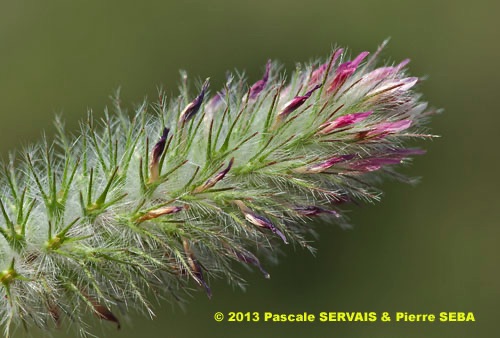
Trifolium angustifolium L.
Fam. : Fabaceae
© Pascale SERVAIS & Pierre SEBA, 2019. Tilo Botanica: Flore de Tilos et du Dodécanèse / Flora of Tilos and of the Dodecanese
English translation by Brenda Bradbury, Howard Bradbury and Stéphane Léonard
Plante herbacée, hermaphrodite, à tiges cylindriques assez raides, étalées puis dressées, ramifiées à la base, couvertes de poils appliqués.
Feuilles alternes, composées trifoliées, pétiolées, à folioles poilues, de 15 à 40 mm de long, de 3 à 4 mm de large, linéaires. Stipules très étroites, ailées, lancéolées, terminées par une longue pointe fine.
Fleurs à symétrie bilatérale, roses, de 8 à 12 mm de long, réunies en longues grappes uniquement terminales, de 15 à 80 mm de long, ovoïdes à cylindriques, portées par un pédoncule de 2 à 4 cm de long. Corolle papilionacée à peine plus courte que les dents du calice ou les égalant. Calice couvert de longs poils blancs jusqu’au sommet, à dents presque égales, très étroites et à tube fermé par 2 protubérances épaisses à maturité. 9 étamines soudées entre elles et 1 libre. Ovaire supère.
Fruits, gousses droites souvent cachées sous le calice persistant.
___________________________
Plant herbaceous, hermaphrodite. Stems cylindrical, rather stiff, spread out then erect, branched at the base, covered in appressed hairs.
Leaves alternate, compound trifoliate, petiolate, with leaflets hairy, from 15 to 40 mm long, from 3 to 4 mm across, linear, pointed. Stipules very narrow, winged, lanceolate, finished by a long thin point.
Flowers bilaterally symmetrical, pink, from 8 to 12 mm long, joined together in long, only terminal racemes, from 15 à 80 mm long, ovoid to cylindrical, carried by a peduncle from 2 to 4 cm long. Corolla papilionaceous, scarcely shorter than the teeth of the calyx or equal to them. Calyx covered in long white hairs up to the top, with very narrow teeth almost equal to each other and with a tube closed by 2 protuberances thick at maturity. 9 stamens fused with each other and 1 free. Ovary superior.
Fruits, straight pods often hidden under the persistent calyx.
Descripteurs / Identifying features
1
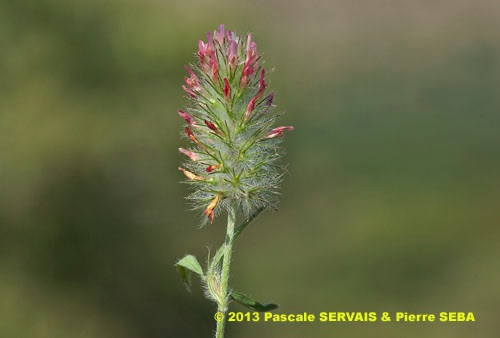
2
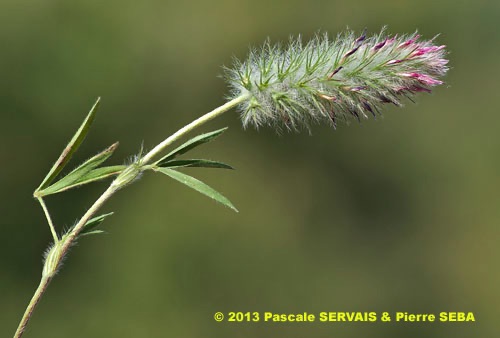
3
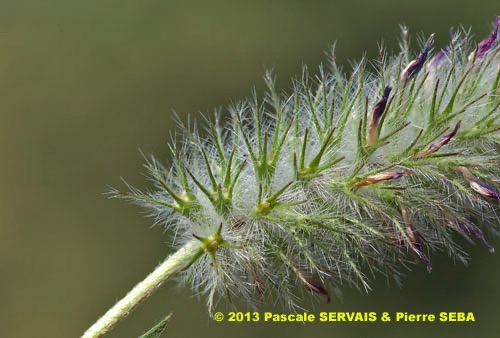
4

5
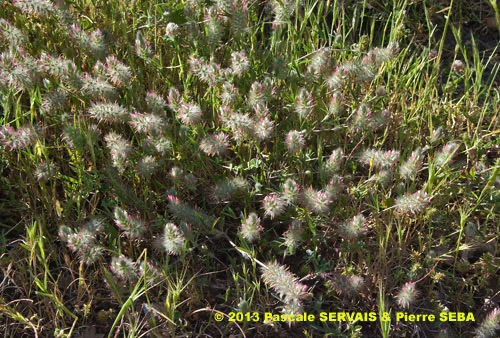
6
Étymologie / Etymology :
Trifolium : emprunt du latin trifolium, -i (nom) [ < tres (adj.) = trois
+ folium, -i (nom) = la feuille ] = le trèfle, nom donné à la plante par
Pline, naturaliste latin mort en 79 apr. J.-C., en référence aux feuilles
à trois folioles caractéristiques.
Angustifolium : adjectif créé par les botanistes
[ < angustus, -a, -um (adj.) = étroit + folium, -i (nom) = la feuille ]
= à feuilles étroites, qui a des feuilles étroites, en référence aux
feuilles presque linéaires.
Trifolium : borrowed from Latin trifolium, -i (noun) [ < tres (adj) = three
+ folium, -i (noun) = leaf ] = clover, name given to the plant by Plinius,
Latin naturalist died in 79 AD, referring to the leaves with three
characteristic leaflets.
Angustifolium : adjective created by botanists
[ < angustus, -a, -um (adj) = narrow + folium, -i (noun) = leaf ]
= with narrow leaves, which has narrow leaves, referring to the
almost linear leaves.
Synonymes / Synonyms :
Trifolium angustifolium subsp. angustifolium
Triphylloides angustifolia (L.) Moench
Noms vernaculaires / Common names :
Noms français / French names :
Queue-de-renard — Trèfle à feuilles étroites —
Trèfle à folioles étroites.
Noms grecs / Greek names :
Αγριοτρίφυλλο — Κατσικλάρι — Τριφύλλι —
Τριφύλλι στενόφυλλο — Τριφύλλι το στενόφυλλον.
Noms anglais / English names :
Narrow clover — Narrow leaf clover — Narrow-leaved clover —
Narrow-leaved trefoil — Narrowleaf crimson clover.
Noms allemands / German names :
Fuchsschwanz-Klee — Schmalblättriger Klee.
Nom espagnol / Spanish name :
Trébol de hoja estrecha.
Noms italiens / Italian names :
Trifoglio a foglie strette — Trifoglio angustifoglio.
Habitat :
Forêts - Cultures - Prairies - Lieux pierreux - Lieux incultes -
Chemins.
Forests - Cultivated places - Meadows - Stony places - Waste ground -
Waysides.
Île / Island :
Tilos.
Hauteur / Height range :
De 10 cm à 30 cm.
From 10 cm to 30 cm.
Floraison / Flowering time :
D’avril à juin.
From April to June.
Groupe / Classification :
Dicotylédones.
Dicotyledons.
Pérennité / Lifespan :
Annuelle.
Annual.
Description :
Clés dichotomiques et descripteurs distinctifs des 15 espèces / Dichotomous keys and distinctive identifying features of the 15 species
Photo 1 :
Localisation / Location : Tilos, Megalochorio, Plaine d’Erystos
Date : 25/04/2013
GPS : Lat. 36,44526° N / Long. 27,34570° E / Alt. 33 m
Type : Photographie numérique / Digital Photograph (10 mégapixels)
Photo 2 :
Localisation / Location : Tilos, Megalochorio, Plaine d’Erystos
Date : 25/04/2013
GPS : Lat. 36,44526° N / Long. 27,34570° E / Alt. 33 m
Type : Photographie numérique / Digital Photograph (10 mégapixels)
Photo 3 :
Localisation / Location : Tilos, Megalochorio, Plaine d’Erystos
Date : 25/04/2013
GPS : Lat. 36,44526° N / Long. 27,34570° E / Alt. 33 m
Type : Photographie numérique / Digital Photograph (10 mégapixels)
Photo 4 :
Localisation / Location : Tilos, Megalochorio, Plaine d’Erystos
Date : 25/04/2013
GPS : Lat. 36,44526° N / Long. 27,34570° E / Alt. 33 m
Type : Photographie numérique / Digital Photograph (10 mégapixels)
Photo 5 :
Localisation / Location : Tilos, Megalochorio, Plaine d’Erystos
Date : 25/04/2013
GPS : Lat. 36,44593° N / Long. 27,34524° E / Alt. 38 m
Type : Photographie numérique / Digital Photograph (10 mégapixels)
Photo 6 :
Localisation / Location : Tilos, Megalochorio, Plaine d’Erystos
Date : 25/04/2013
GPS : Lat. 36,44593° N / Long. 27,34524° E / Alt. 38 m
Type : Photographie numérique / Digital Photograph (10 mégapixels)

Google Maps
Google Maps
Google Maps
Google Maps
Google Maps
Google Maps